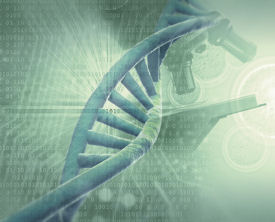Unraveling autism's many causes, spread across the genome
Despite the 90% heritability of autism, suggesting a very strong genetic component to its etiology, zeroing in on the genetic underpinnings of this disorder has been very challenging.
Autism and the related autism spectrum disorders are an enigmatic and substantial cause of developmental delay. Affecting up to 0.5-1% of children and recognized as a growing issue in adult populations, autism affects most by the age of 3 and is considerably more common in males than females.
Individuals with autism exhibit complex behavioral abnormalities, including disordered communication, abnormal social interactions and stereotyped repetitive behaviors often associated with cognitive impairment. Autistic spectrum disorders can confer considerable lifelong disability, and no preventive strategies or curative treatments exist.

The causes of autism have been the subject of debate—much of it occurring in the public eye—but it seems likely that the disorder results from a complex interaction of yet-to-be-identified environmental and genetic factors. Despite the 90% heritability of autism, suggesting a very strong genetic component to its etiology, zeroing in on the genetic underpinnings of this disorder has been very challenging.
In the last few years this has begun to change. Mounting evidence suggests that a type of DNA alteration called copy number variation (CNV) plays an important role in the disorder. Copy number variations are regions of DNA that may be duplicated or deleted to change the normal complement of two copies of any given stretch of DNA. This variation in copy number may affect one or many genes. These discoveries open new realms for developing novel diagnostic and therapeutic approaches to autism.
It has long been recognized that features of autism occur in individuals with large scale aberrations in chromosomal structure. The diagnostic workup of patients with features of autism and developmental delay often includes studies that examine the macroscopic structure of chromosomes (so called cytogenetic studies including fluorescent in situ hybridization and more recently comparative genomic hybridization). Macroscopic changes can be detected in about 7% of cases.
However a substantial number of patients have no evident large changes in their DNA. The advent of genome-wide association studies designed to look at the association of single nucleotide polymorphisms in the genome proved disappointing when applied to autism until the technologies evolved to the point where the presence or absence of small copy number variations (variably sized insertions and deletions of the DNA that can be as small as a few base pairs in length) could be reliably measured.
Subsequently, several studies have demonstrated convincing associations between copy number variations and autism at multiple locations throughout the genome. Interestingly these variations have been shown to arise in the setting of apparently sporadic cases (de novo or new mutations) as well as in the setting of more clearly inherited cases. It is now thought that a significant percentage of cases (perhaps as high as 44%) arise from this type of variation in DNA sequence.
Not surprisingly, CNVs in certain regions of the DNA are found in multiple cases. However the situation is complex. Variation in a great variety of regions of DNA can apparently lead to the common phenotype of autism.
The rarity of any one CNV in panels of patients with autism probably reflects not only the complexity of the biology of higher cognitive function, but a principle of population genetics. Unlike late onset conditions such as diabetes and heart disease, there is a high reproductive disadvantage to individuals affected by autism. Consequently, one might reasonably predict that it would be very unlikely that any one gene mutation that confers high disease risk will attain high population prevalence. This fact has implications for making a molecular diagnostic test. Any proposed testing platform will need to be capable of measuring copy number variations across the entire genome. As well, the observation that many genes can contribute to a common clinical picture suggests that the search for therapeutic strategies may be arduous.
Perhaps future studies will be able to identify relationships between seemingly disparate individual regions of CNV, thereby identifying causal pathways that may be amenable to targeted therapeutic development. Finally, large scale studies with longitudinal follow-up to examine genes by environment interactions are imperative if successful preventive strategies are to be developed.
Autism and the autism spectrum of disorders are of tremendous societal importance. Advances in genomic technologies are providing some exciting insights on these disorders and are once again showing that we have much to learn about ourselves.



